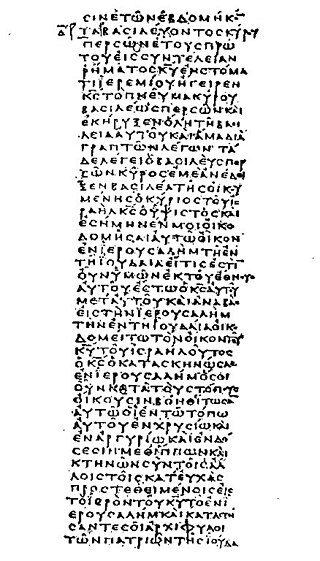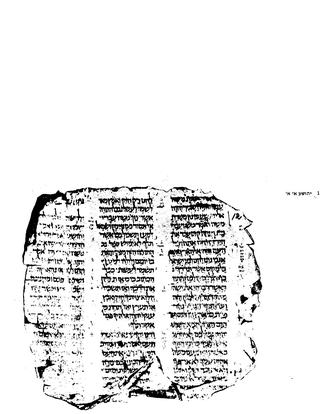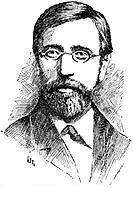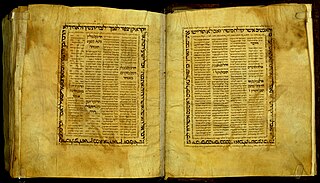
The Septuagint, sometimes referred to as the Greek Old Testament or The Translation of the Seventy, and often abbreviated as LXX, is the earliest extant Greek translation of the Hebrew Bible from the original Biblical Hebrew. The full Greek title derives from the story recorded in the Letter of Aristeas to Philocrates that "the laws of the Jews" were translated into the Greek language at the request of Ptolemy II Philadelphus by seventy-two Hebrew translators—six from each of the Twelve Tribes of Israel.

The Masoretic Text is the authoritative Hebrew and Aramaic text of the 24 books of the Hebrew Bible (Tanakh) in Rabbinic Judaism. The Masoretic Text defines the Jewish canon and its precise letter-text, with its vocalization and accentuation known as the mas'sora. Referring to the Masoretic Text, masorah specifically means the diacritic markings of the text of the Jewish scriptures and the concise marginal notes in manuscripts of the Tanakh which note textual details, usually about the precise spelling of words. It was primarily copied, edited, and distributed by a group of Jews known as the Masoretes between the 7th and 10th centuries of the Common Era (CE). The oldest known complete copy, the Leningrad Codex, dates from the early 11th century CE.

The Samaritan Pentateuch, also called the Samaritan Torah, is the sacred scripture of the Samaritans. Written in the Samaritan script, it dates back to one of the ancient versions of the Torah that existed during the Second Temple period. It constitutes the entire biblical canon in Samaritanism.

The Aleppo Codex is a medieval bound manuscript of the Hebrew Bible. The codex was written in the city of Tiberias in the tenth century CE under the rule of the Abbasid Caliphate, and was endorsed for its accuracy by Maimonides. Together with the Leningrad Codex, it contains the Aaron ben Moses ben Asher Masoretic Text tradition.

The Leningrad Codex or Petrograd Codex is the oldest known complete manuscript of the Hebrew Bible in Hebrew, using the Masoretic Text and Tiberian vocalization. According to its colophon, it was made in Cairo in AD 1008.

Chumash is a Torah in printed in book bound form as opposed to a Torah scroll.

The Biblia Hebraica Stuttgartensia, abbreviated as BHS or rarely BH4, is an edition of the Masoretic Text of the Hebrew Bible as preserved in the Leningrad Codex, and supplemented by masoretic and text-critical notes. It is the fourth edition in the Biblia Hebraica series started by Rudolf Kittel and is published by the Deutsche Bibelgesellschaft (German Bible Society) in Stuttgart.

A Mikraot Gedolot, often called a "Rabbinic Bible" in English, is an edition of the Hebrew Bible that generally includes three distinct elements:

The Codex Cairensis is a Hebrew manuscript containing the complete text of the Hebrew Bible's Nevi'im (Prophets). It has traditionally been described as "the oldest dated Hebrew Codex of the Bible which has come down to us", but modern research seems to indicate an 11th-century date rather than the 895 CE date written into its colophon. It contains the books of the Former Prophets and Latter Prophets. It comprises 575 pages including 13 carpet pages.
Jewish printers were quick to take advantages of the printing press in publishing the Hebrew Bible. While for synagogue services written scrolls were used, the printing press was very soon called into service to provide copies of the Hebrew Bible for private use. All the editions published before the Complutensian Polyglot were edited by Jews; but afterwards, and because of the increased interest excited in the Bible by the Reformation, the work was taken up by Christian scholars and printers; and the editions published by Jews after this time were largely influenced by these Christian publications. It is not possible in the present article to enumerate all the editions, whole or partial, of the Hebrew text. This account is devoted mainly to the incunabula.
Hebrew orthography includes three types of diacritics:
The Jerusalem Crown is a printed edition of the Tanakh printed in Jerusalem in 2001, and based on a manuscript commonly known as the Aleppo Crown). The printed text consists of 874 pages of the Hebrew Bible, two pages setting forth both appearances of the Ten Commandments each showing the two different cantillations—for private and for public recitation, 23 pages briefly describing the research background and listing alternative readings, a page of the blessings—the Ashkenazic, Sephardic and Yemenite versions—used before and after reading the Haftarah, a 9-page list of the annual schedule of the Haftarot readings according to the three traditions.

Papyrus Rylands 458 is a manuscript of the Pentateuch in the Greek Septuagint version of the Hebrew Bible. It is a roll made from papyrus, which has survived in a very fragmentary condition. It is designated by the number 957 on the list of Septuagint manuscripts according to the numbering system devised by biblical scholar Alfred Rahlfs. Using the study of comparative writing styles (palaeography), the manuscript has been dated to the middle of the 2nd century BCE.

Seligman (Isaac) Baer (1825–1897) was a Masoretic scholar, and an editor of the Hebrew Bible and of the Jewish liturgy. He was born in Mosbach, the northern district of Biebrich, on 18 September 1825 and died at Biebrich-on-the-Rhine in March 1897.

The Damascus Pentateuch or Codex Sassoon 507 is a 10th-century Hebrew Bible codex, consisting of the almost complete Pentateuch, the Five Books of Moses. The codex was copied by an unknown scribe, replete with Masoretic annotations. The beginning of the manuscript is damaged: it starts with Genesis 9:26, and Exodus 18:1–23 is also missing. In 1975 it was acquired by the Jewish National and University Library, Jerusalem. The codex was published in a large, two-volume facsimile edition in 1978.

Yemenite scrolls of the Law containing the Five Books of Moses represent one of three authoritative scribal traditions for the transmission of the Torah, the other two being the Ashkenazi and Sephardic traditions that slightly differ. While all three traditions purport to follow the Masoretic traditions of Aaron ben Moses ben Asher, slight differences between the three major traditions have developed over the years. Biblical texts proofread by ben Asher survive in two extant codices, the latter said to have only been patterned after texts proofread by Ben Asher. The former work, although more precise, was partially lost following its removal from Aleppo in 1947.
Codex Babylonicus Petropolitanus, designated by Vp, is an old Masoretic manuscript of Hebrew Bible, especially the Latter Prophets, using Babylonian vocalization. This codex contains the books of Isaiah, Jeremiah, Ezekiel, and the Minor Prophets, with both the small and the large Masora.

Damascus Crown, Keter Damascus, is a complete Hebrew Bible manuscript containing 24 canonical books written in the 13th century CE, and brought by stealth to Israel from Damascus, Syria in 1993. Today, it is housed at the Hebrew University and National Library of Israel, in Jerusalem, under a public trust. The manuscript is not to be confused with the Damascus Pentateuch.

Codex S1 is a Masoretic codex comprising all 24 books of the Hebrew Bible, dated to the 10th century CE. It is considered as old as the Aleppo Codex and a century older than the Leningrad Codex, the earliest known complete Hebrew Bible manuscript. Alternatively, it might be dated to the late 9th century. The Aleppo Codex was missing 40% of its leaves when it resurfaced in Israel in 1958, while in Codex S1 only twelve leaves are completely missing and hundreds more are partially lost. The scribe of S1 was unusually sloppy, frequently forgetting punctuation, diacritical marks, and vowels; he also errs in his consonantal spelling on dozens of occasions.














